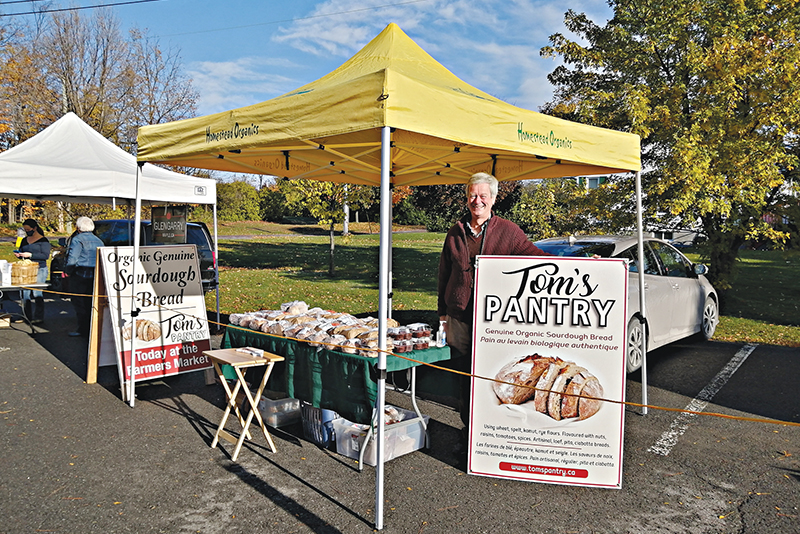Tom Manley displays his products at the Vankleek Hill Market. Courtesy photo
By Tom Manley
AgriNews Contributor
It’s the season… to decide and prepare to participate in a farmers’ market for the 2021 season.
Several farmers’ markets in Eastern Ontario are now inviting farmers and food artisans to join their farmers’ market for the 2021 season, typically from May to October. I have seen notices from the new farmers’ market in Monkland and the Ottawa Markets at Parkdale and Byward. Other markets will soon send out their notices.
If you were wondering why you do not have a farmers’ market in your community, or a market tried but later closed, there are several good reasons. First and foremost, markets cannot find enough farmers in direct marketing.
Contemporary agriculture moved to big commodities for the production volume, the mechanization, and the simplicity. There has not been enough focus by the government, the farm sector, and the public to maintain a viable space for farms in direct marketing. Consequently, farmers markets rely a lot (up to 49 per cent of the vendors for an official farmers’ market) on prepared foods from inspected and non-inspected kitchens and non-food crafters.
Secondly, the public has not sufficiently supported the market. Consumers are used to lowest-price, one-stop, all-season shopping at the grocery stores. For all this talk during the pandemic of buying local, the concept still has limited traction. It is like trying to retain local retail, local gas stations, or the train; use it or loose it!
This was the case of the farmers’ market in Chesterville, which I attended in 2019 as a bread baker. After the novelty wore off, the consumer visits dwindled and many vendors left. I left also and moved to the Metcalfe Farmers’ Market where the community support is strong. For the winter season, I moved to the Vankleek Hill all-seasons Farmers’ Market where volunteer and community supports are very strong. Thirdly, a farmers’ market is a lot of work. The market requires engaged volunteers and/or enough vendors to afford to pay a weekly manager.
Should your business attend a farmers’ market, assuming that you operate a farm in direct marketing or a prepared food business?
It boils down to the cost and convenience of selling versus the income. In other words, how does the cost or effort to attend a farmers’ market compare to other distribution options?
Some vendors fit well with farmers’ markets. Others have chosen other channels: the CSA model (seasonal subscriptions), on-farm stands, wholesale markets, sometimes in combination with a farmers’ market.
The farmers’ market is a great fit for the vendor who is not a great salesperson because the customers come to the market, in a given location, on a specific schedule, with little marketing effort by each vendor. The vendors have a simple job: guess and adjust to the customer traffic, make enough inventory to either match their production capacity or match the customer traffic at the market, and show up at the market. A good product in combination with a pleasant character and long-term presence will generate good sales, if the market has enough traffic.
The disadvantage of a farmers’ market is the inefficient sales time spent at a slow market, and the personal loss of summer weekends.
A very entrepreneurial vendor may find a good fit in other channels that require an ongoing investment in advertising and promotion, weekly newsletters, outreach activities to find customers, a flexible schedule, a process to handle orders, and driving around the countryside to complete deliveries.
At the farmers’ market, the cost of selling includes the fee for the stall, the vehicle costs to make the trip, the cost of labour in packing, travelling, selling, and unpacking, and the loss of perishable inventory that did not sell.
The fixed cost of selling at the market should be weighed against the income of the day. The cost of selling should be in the range of about 25-50 per cent, preferably closer to 30 per cent. When the vendor hires staff to attend the market, then the cost calculation is clear.
As examples, Avonmore Berry Farm, Rochon Gardens, and Les Jardins Lamoureux attend several markets and roadside stands with hired staff. They are large operations at high traffic locations and their fresh vegetables move quickly. I estimate that they sell enough to keep the cost of selling below 30 per cent of the income each day.
Small slow markets can fit owner-operators who count their weekend time as free! They are happy with modest sales at a rural market to cover their input costs and some production time. That is fine if the vendor has nothing else to do on the weekend, counts the market as a hobby or as a complementary sales channel, and has other income to cover the cost of living.
There are potential matches for various market situations and different kinds of vendors. It all boils down to the operator’s sales expectations, the cost of selling, the production volume, and the value of personal time.












